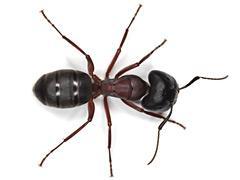
The red carpenter ant and the black carpenter ant are two of the most common types found in Canada. The red carpenter ant has a dark brownish-black body, with a reddish-brown upper body. The black carpenter ant is dark brownish-black all over.
Carpenter ants are from 6 to 25 mm (.24 to 1 inch) long. A carpenter ant’s body is divided into three segments, with a very slim waist separating the upper body and lower body. Their antennae are bent and in sections. Male and female adults have wings at mating time.